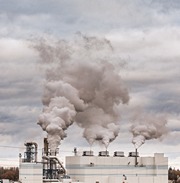SEI researchers in Tallinn, York and the U.S. are exploring measures to reduce short-lived climate pollutants (SLCPs) in Estonia and using a new calculator to estimate the potential benefits.

Estonia has some of the cleanest air in Europe, yet air pollution – especially small particulate matter (PM2.5) – still contributed to an estimated 650 premature deaths in 2012 alone. As a member of the EU, Estonia has also pledged under the Paris Agreement to reduce greenhouse gas emissions by at least 40% from 1990 levels by 2030.
One way to tackle both challenges at once is to reduce short-lived climate pollutants (SLCPs) such as black carbon (soot), methane, tropospheric ozone and hydrofluorocarbons (HFCs). These substances don’t stay in the atmosphere for very long – from a few days, to up to 20 years – but they have a powerful effect on global warming. They are also associated with human health impacts, reduced crop yields and other serious problems.
When Estonia’s and Sweden’s environment ministers met in Stockholm three years ago, a key item on the agenda was whether Estonia should join the Climate and Clean Air Coalition to Reduce Short-Lived Climate Pollutants (CCAC), which Sweden co-founded.
Estonia has yet to join CCAC, but a new study by SEI, using tools being developed in partnership with the Coalition, is quantifying the potential benefits for the first time.

The main sources of SLCP emissions in Estonia are in four sectors: energy, transport, agriculture and housing, said Tiit Kallaste, a senior expert at SEI Tallinn. The first phase of the study, financed by the Estonian Environmental Investment Centre, focuses on housing and transport in particular.
“The burning of fuels is responsible for the lion’s share of PM2.5 emissions, which are extremely hazardous for human health,” Kallaste added. “These tiny particles can pass through our nose hair and enter our lungs and blood system, causing respiratory diseases and other health problems.” Burning of fuels also produces black carbon and nitrogen oxide (NOx) emissions.
As part of a CCAC initiative to support national SLCP action planning, SEI has developed a benefits calculator called LEAP-IBC, working with partners at the U.S. Environmental Protection Agency and at the University of Colorado. The tool is integrated with SEI’s Long-range Energy Alternatives Planning (LEAP) system, so planners can see how any given measure could affect not only the energy system and greenhouse gas emissions, but also human health and other policy concerns.
SEI has started to apply LEAP-IBC in countries in Africa, Latin America and Asia. For the Estonia study, SEI Tallinn researchers teamed up with LEAP developer Charlie Heaps, of SEI-US, and Chris Malley and Harry Vallack of SEI York, developers of LEAP-IBC.
“We adapted the model to make calculations based on available local statistics on fuels, the technologies used for generating electricity and heat, current emissions, the geographical location of the population and changing parameters of economic activity,” Malley explained. The LEAP-IBC tool allowed them to create forward-looking scenarios and make projections to 2030.
Several of the potential interventions in the Estonian transport sector that SEI Tallinn explored involved measures to renew the local vehicle fleet, by providing incentives to buy more energy-efficient vehicles, introducing a CO2-based car tax, and taxing older, heavily polluting cars. They also considered road taxes for heavy-duty vehicles, steering demand from road transport towards rail and marine transport, as well as redirecting heavy-duty vehicles away from residential areas and city centres. In addition, SEI Tallinn explored traffic calming measures as potential ways to decrease the amount of SLCPs in urban air.
Other measures considered aim to incentivize biking, walking and public transport in urban areas as much as possible, to slow growth in the use of personal cars. Because Estonian towns are relatively small, SEI Tallinn experts believe it would not be very challenging to create new mobility options and thereby reduce car dependency.
In the housing sector, better fuels and burning technologies for heating apartment blocks as well as private houses are seen as a solution for contributing to better air quality. For example, in Estonia, where over 50% of the territory is covered with forests, wood is widely used for heating houses. However, the wood used should dry for at least three summers, so it will burn thoroughly when ignited; still-humid wood creates a great deal of soot.
Another key measure in the housing sector is to renovate buildings to make them more energy-efficient, which is particularly important because heating houses in the cold Nordic climate uses large amounts of energy.

Calculations by the LEAP-IBC model in the transport and housing sectors showed that by implementing the energy efficiency measures noted above, together with the ones foreseen in the Estonian National Development Plan of the Energy Sector until 2030 (ENMAK 2030+), 197 premature deaths could be avoided by 2030.
SEI Tallinn aims to research this topic further in collaboration with SEI York in order to assess the effects of another SLCP, ozone, on local environment and health. The continued research would also need to include the energy and agriculture sectors as the contributors to the local air quality. Since Estonia relies on its oil shale industry for energy independence, including the energy sector in the next phase of research can give a more accurate overview of the role of SLCPs in the local air quality.
Kallaste also noted that the role of neighbouring countries via transboundary transfer of SLCPs is also surprisingly big, based on the recent European Monitoring and Evaluation Programme (EMEP) report on Estonia. “This highlights the importance of regional dialogue and cooperation,” he said.
Learn more about the SEI Initiative on Low Emission Development Pathways (LED-P) »
Design and development by Soapbox.